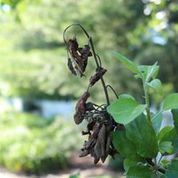Introduction to fire blight
Fire blight epidemics are often sporadic, but can be devastating if optimal conditions are met.
Erwinia amylovora favors rain and temperatures above 60 degrees F. If these conditions are met during apple and pear
bloom and early growth stages, infection can be severe.
Initial fire blight infections occur through flowers.
Petal browning is the first sign of petal blight, but many growers do not notice it. Browning of
pedicels (stems that attach flowers to stems) follows. Often, droplets of bacterial ooze can be seen
coming from pedicels (Figure 1). Bacteria travel down spurs and into twigs. Cankers that
form around spur-attachment sites girdle branches, and then branch parts above cankers also die (Figure 2).
Shoot blight occurs after flowering.
This is the most obvious fire blight symptom in which infected shoots die quickly, causing branch tips
to form a distinct crook (Figure 3). Shoot blight, however, does not result from infection of blossoms. Direct
penetration of bacteria into green shoots or the upper leaves of young shoots after bloom typically causes
shoot blight symptoms.
More information on fire blight can be found in:
PPFS-FR-T-12
Spray recommendations for commercial growers
ID232
and homeowners
ID-21
are also available online.



Figure 1 Initial infection by the fire blight pathogen occurs through blossoms.
Figure 2 Bacteria can spread through flowers and spurs into twigs. Resulting cankers can girdle entire limbs and branches.
Figure 3 Blighting of shoots, also called shepherd's crook, is the most recognized symptom of fire blight on apple.
Notes
Trees must be in bloom in order to determine risk for blossom blight phase of fire blight. Trees must be actively growing (1 to 4 weeks past bloom) in order to determine risk for shoot blight. This model incorporates the previous 4 days of weather data and 7-day forecast for estimating leaf wetness and temperature, thereby estimating risk for bacterial growth and infection.
Instructions
• Select county from drop-down menu using arrows.
• Select today's date to determine current risk for fire blight. Other dates may be entered if assessment of past risk is warranted.
• Determine orchard history.
• Click 'submit choices'.
.
These data are based on the 24 hour period 7 PM to 7 PM
Data should NOT BE USED FOR LEGAL PURPOSES.
Fire Blight Maps for All Kentucky Counties